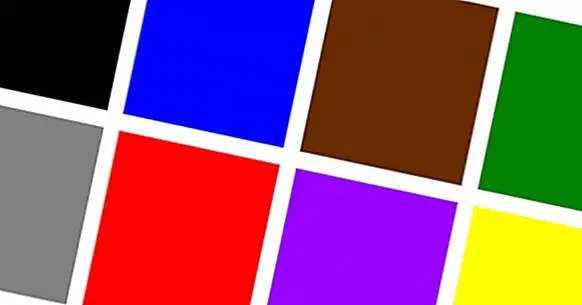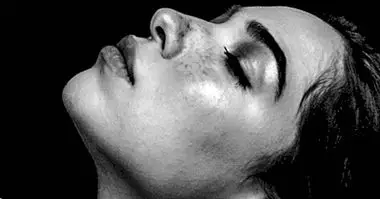The Lüscher Test: what it is and how it uses colors
The Lüscher test is a projective evaluation technique that part of relating the preference or the rejection of different colors with the expression of certain psychological states. It is a widely used test in different areas and has given rise to different controversies due to the nature of its application and its methodological criteria.
We will see below what are some of the theoretical foundations from which the Lüscher Test starts, to then explain the process of application and interpretation, and finally, present some of the criticisms that have been made.
- Related article: "Types of psychological tests: their functions and characteristics"
Origins and theoretical foundations of the Lüscher Test
In the year 1947, and after having studied the relationship between color and different psychological diagnoses, Swiss psychotherapist Max Lüscher created a first test of emotional and psychological evaluation based on the preference for certain colors and their relationship with the personality.
It is a projection type test, that is, an instrument for the exploration of personality and psychism used for diagnostic purposes in different areas such as clinical, work, educational or forensic. Being projective, it is a test that seeks to explore psychic dimensions that can not be accessed by other means (for example, through verbal language or observable behavior).
Broadly speaking, the Lüscher Test is based on the idea that the serial choice of eight different colors can account for a particular emotional and psychosomatic state.
The relationship between colors and psychological needs
The Lüscher Test starts by relating the theory of fundamental and complementary colors, with the fundamental needs and needs that indirectly intervene in psychological mechanisms.
In other words, he takes up the psychology of colors to establish a relationship between psychological reactions and chromatic stimuli , where it is assumed that each individual reacts psychologically in the presence of a certain color. Thus, chromatic stimulation can activate reactions that speak of the satisfaction, or dissatisfaction, of fundamental psychological needs.
The above is considered as a universal phenomenon and shared by all people, regardless of cultural context, gender, ethnic origin, language or other variables. Likewise, it defends itself under the argument that all individuals share a nervous system that allows responding to chromatic stimulation, and with this, activate various psychological mechanisms .
- Maybe you're interested: "The main theories of personality"
Objective component and subjective component
The luscher test takes into consideration two elements that relate psychological states with the choice of certain colors. These elements are the following:
- Colors have an objective meaning, that is, the same chromatic stimulation causes the same psychological reaction in all individuals.
- However, each person establishes a subjective attitude that can be, either preferably, or rejection of the chromatic stimulus.
That is, part of considering that all people can perceive the different color ranges equally, as well as experiencing the same sensations through them. It attributes an objective character to the experiential quality associated with each color . For example, the red color would activate a stimulating and arousing sensation in all people, independently of variables external to the people themselves.
To this last one a subjective character is added, since it maintains that, by the same sensation of excitation that the red color provokes, a person can prefer it and another one can perfectly reject it.
Thus, the Lüscher Test considers that the choice of colors has a subjective character that can not be faithfully transmitted through verbal language, but which can be analyzed by means of the apparently random choice of colors . This would allow us to realize how people really are, how they look or how they would like to see themselves.
Application and interpretation: what do colors mean?
The application procedure of the Lüscher Test is simple. The person is presented with a bunch of cards of different colors, and you are asked to choose the card that you like the most . Then you are asked to order the rest of the cards according to your preference.
Each card has a number on the back, and the combination of colors and numbers allows an interpretation process that depends, on the one hand, on the psychological meaning that this test attributes to each color, and on the other, depends on the order in which the person has accommodated the cards.
Although the application of the test is based on a simple procedure, its interpretation is quite complex and delicate (as is often the case with projective tests). Although it is not a sufficient condition, to perform the interpretation it is necessary start by knowing the meaning that Lüscher attributes to the choice or rejection of the different colors .
They are known as "Lüscher colors" because they are a range of colors that have a particular color saturation, different from that found in everyday objects. Lüscher chose them from a collection of 400 different chromatic varieties, and the criterion for their selection was the impact that it generated on the people observed. This impact included both psychological and physiological reactions. To structure your test, classify them as follows.
1. Basic or fundamental colors
They represent the fundamental psychological needs of the human being. It is about the colors blue, green, red and yellow. In very broad strokes, blue is the color of the involvement it affects, so it represents the need for satisfaction and affection. Green represents the attitude towards oneself and the need for self-affirmation (the defensiveness of the self). Red refers to excitement and the need to act , and finally, yellow represents the projection (understood as a search for horizons and the reflection of an image) and the need to anticipate.
Reporting a pleasant perception to the presence of these colors, is for Luscher an indicator of a balanced psychology and free of conflicts or repressions.
2. Complementary colors
It's about the colors violet, brown (brown), black and gray. Contrary to the basic or fundamental colors, the preference for complementary colors can be interpreted as an indicator of experience of stress, or of a manipulative and negative attitude. Although they can also indicate some positive qualities according to how they are placed. Also, the choice of these colors is associated with people who have low preference or rejection experiences.
The violet color is representative of transformation, but it is also an indicator of immaturity and instability. Coffee represents the sensory and the body, that is, it is directly connected to the body, but having little vitality, its exaggerated choice can indicate stress. The gray, on the other hand, is indicative of neutrality, indifference and possible isolation, but also of prudence and composure. Black is representative of renunciation or abandonment, and to a maximum degree, it can indicate protest and anguish.
3. The white color
Finally the white color works as the contrasting color of the previous ones. However, it does not have a fundamental role in the psychological and evaluative meanings for this test.
The position
The interpretation of the test is not completed only by attributing a meaning to each color. As we said before, Lüscher connects these meanings with the subjective experience of who is being evaluated. That is to say that the results of the test depend to a large extent on the position in which the person has accommodated the color cards . For Lüscher, this last one gives account of the position and the direction of the individual behavior, that can be Directive, Receptive, Authoritarian or Suggestable.
This behavior can, in turn, be in a constant or variable position; what varies according to how the link is established with the other subjects, the objects and the interests of the individual. The interpretive procedure of the Lüscher Test is done based on an application manual which includes different combinations and positions of colors with their respective meanings.
Some criticisms
In methodological terms, for Seneiderman (2011) the projective tests have value as "bridge hypothesis", since they allow to establish connections between metapsychology and the clinic, as well as to explore dimensions of subjectivity, which otherwise would not be intelligible. By starting from the ambiguity and the wide freedom of the answers, these tests allow access to elements sometimes difficult to verbalize such as fantasies, conflicts, defenses, fears, etc.
However, as with other projective tests, Lüscher's has been attributed a "subjective" interpretation modality, meaning that its interpretation and results depend to a great extent on the personal criteria of each psychologist or specialist who applies it . That is, it is concluded that it is a test that does not offer "objective" conclusions, which has generated many criticisms.
In the same sense, it is criticized the impossibility of generalizing its findings, due to the lack of standardizations that meet the methodological criteria of objectivity of traditional science.Criteria that support, for example, psychometric tests. In this sense, the projective tests have a scientific status that has caused considerable controversy, especially among specialists who consider this type of test as "reactive" and that in the best of cases have been proposed to systematize them quantitatively.
Therefore, this test has been criticized for lack of criteria that could ensure both its reliability and the low possibility of reproducing its results. On the other hand, The ideas of functionality and pathology have also been criticized (and the possible reproduction of biases, prejudices or stigmas of various kinds), which theoretically support the interpretations of this test.
Bibliographic references:
- Muñoz, L. (2000). Lüscher test I. Application and interpretation. Retrieved August 14, 2018. Available at // s3.amazonaws.com/academia.edu.documents/48525511/luscher_manual_curso__I.pdf?AWSAccessKeyId=AKIAIWOWYYGZ2Y53UL3A&Expires=1534242979&Signature=mY9dvdEukwzWDzpDFPUGgFzgoRo%3D&response-content-disposition=inline%3B%20filename%3DLuscher_manual_curso_I .pdf.
- Sneiderman, S. (2011). Considerations about reliability and validity in projective techniques. Subjectivity and cognitive processes. (15) 2: 93-110.
- Vives Gomila, M. (2006). Projective tests: Application to clinical diagnosis and treatment. Barcelona: University of Barcelona.



















